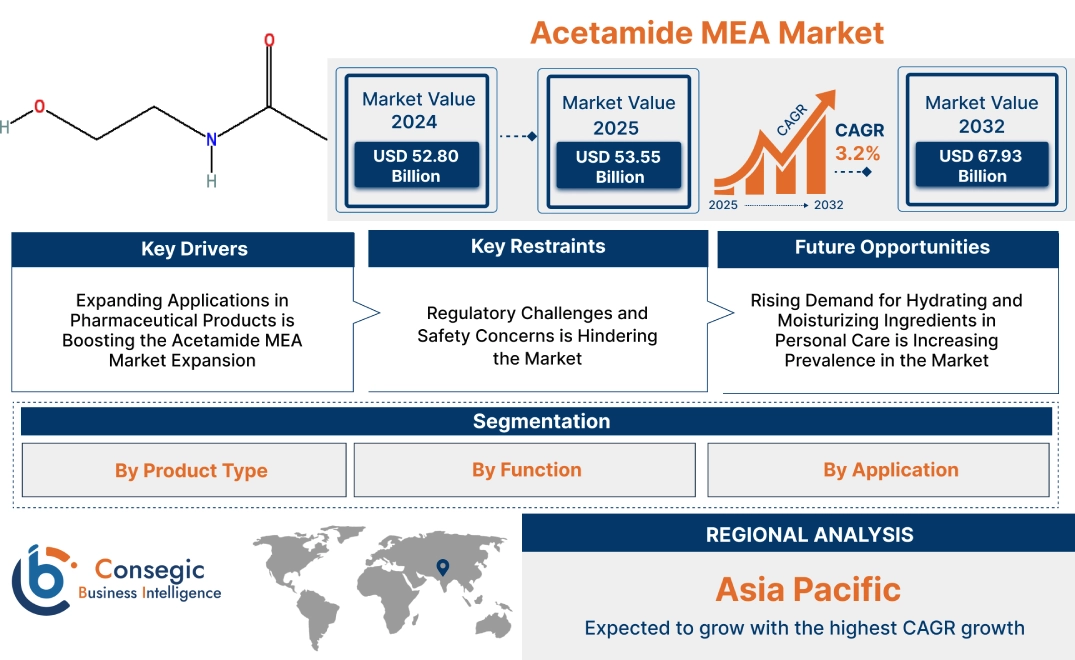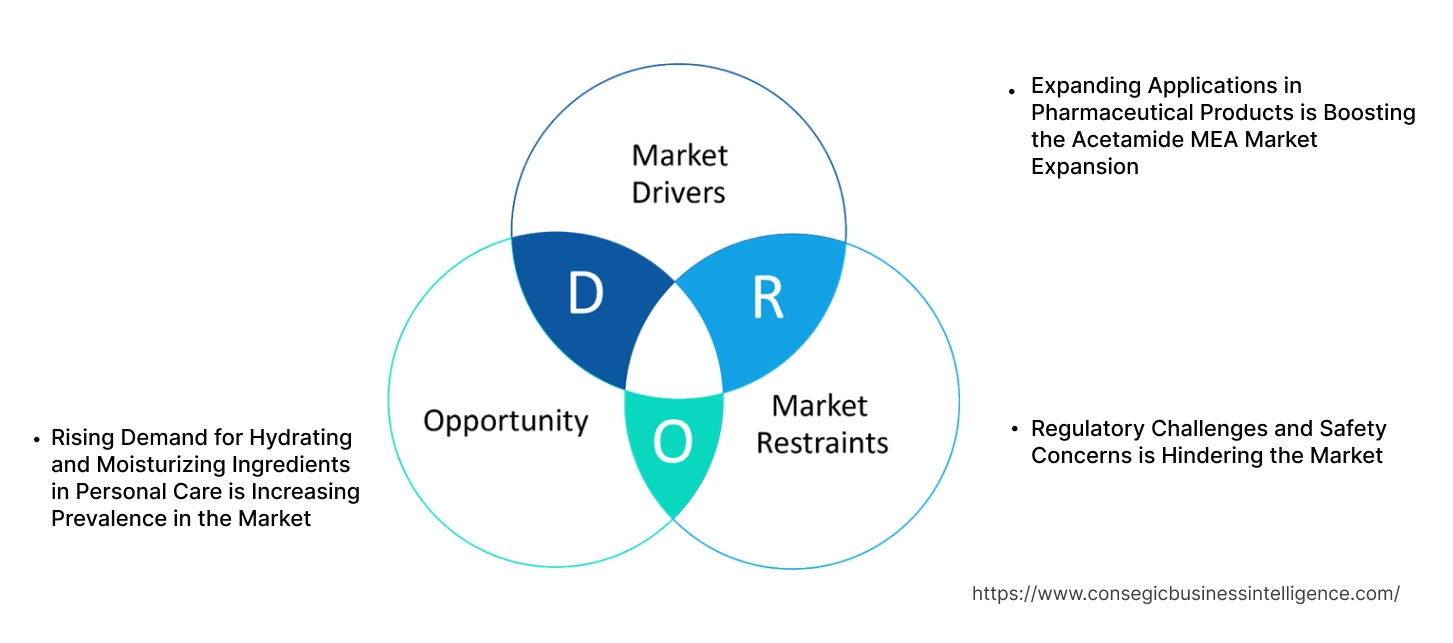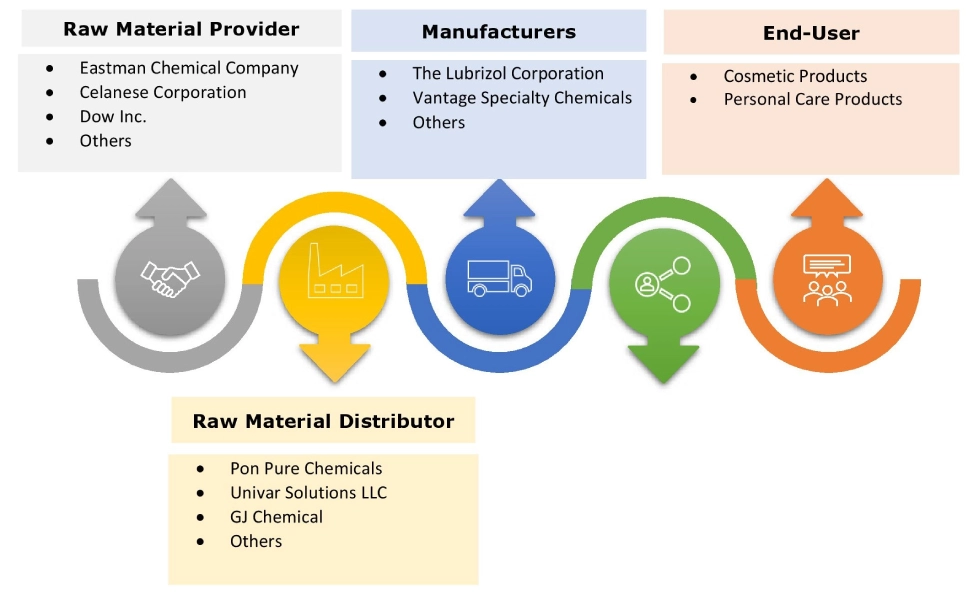Acetamide MEA Market Size:
Acetamide MEA Market size is estimated to reach over USD 67.93 Billion by 2032 from a value of USD 52.80 Billion in 2024 and is projected to grow by USD 53.55 Billion in 2025, growing at a CAGR of 3.2% from 2025 to 2032.
Acetamide MEA Market Scope & Overview:
Acetamide MEA (acetamide monoethanolamine) refers to a water-soluble compound that is primarily used in cosmetic and personal care products for its humectant and skin-conditioning properties. Acetamide monoethanolamine acts as an effective moisture-binding agent, which helps improve the texture and hydration of formulations. Moreover, it offers a range of benefits including compatibility with various ingredients and excellent solubility, which are key aspects for increasing its application in skincare and haircare formulations. Additionally, acetamide monoethanolamine also offers other benefits such as improved moisture retention, enhanced product performance, and suitability for sensitive skin applications. It is used in several cosmetics & personal care products including moisturizers, lotions, shampoos, conditioners, and others.
How is AI Impacting the Acetamide MEA Market?
AI is subtly but increasingly impacting the Acetamide MEA market, primarily through its influence on the broader chemical and cosmetic industries that utilize it. In chemical synthesis, AI can optimize production processes for Acetamide MEA, leading to improved efficiency, reduced waste, and potentially lower costs. For cosmetic manufacturers, AI-powered systems are crucial in accelerating ingredient discovery, predicting formulation stability, and developing personalized products. This means AI can help identify new uses or optimize existing applications for Acetamide MEA, ultimately driving demand. Furthermore, AI contributes to more precise quality control and demand forecasting, leading to a more streamlined and responsive supply chain for this versatile ingredient.
Acetamide MEA Market Dynamics - (DRO) :
Key Drivers:
Rising cosmetics production is propelling the acetamide MEA market growth
Acetamide monoethanolamine is a common ingredient used in cosmetic products due to its moisturizing and conditioning properties. Moreover, it also functions as a humectant in cosmetic products, which enables the products to attract and retain moisture in the skin, thereby promoting hydration and softness. Additionally, acetamide monoethanolamine is also used in cosmetic products as a pH adjuster and emulsifier, which helps enhance the stability of cosmetic formulations. As a result, the rising cosmetics production is driving the adoption of acetamide MEA.
- For instance, according to the Japan Cosmetic Industry Association (JCIA), cosmetic shipments in Japan reached approximately USD 9.23 billion in 2023, witnessing an increase of 2.9% increase as compared to 2022.
Therefore, the rising cosmetics production is driving the adoption of acetamide MEA, in turn proliferating the acetamide MEA market size.
Key Restraints:
Regulatory challenges and safety concerns are restraining the acetamide MEA market
Acetamide monoethanolamine often faces regulatory challenges due to concerns related to its potential toxicity and environmental impact. Regulatory bodies enforce strict guidelines regarding the use of acetamide monoethanolamine in cosmetics & personal care products, specifically concerning permissible concentration levels. These requirements usually necessitate rigorous testing and certification, which increases production costs and time to market for manufacturers.
Moreover, variations in regulatory frameworks across multiple regions often complicate compliance for global players, thereby limiting the ease of market entry. Further, the rising consumer preference for clean-label products and natural alternatives often places synthetic ingredients such as acetamide monoethanolamine under scrutiny. Therefore, the above factors are hindering the acetamide MEA market expansion.
Future Opportunities :
Growing demand for hydrating and moisturizing ingredients in personal care products is expected to drive the acetamide MEA market opportunities
The rising focus on hydration in personal care products such as shampoo, conditioners, body wash, and others presents significant opportunities for market growth. Acetamide monoethanolamine plays a crucial role in haircare products for enhancing moisture retention, improving texture, and delivering a smooth finish. Moreover, acetamide monoethanolamine’s compatibility with synthetic and natural ingredients enables formulators to manufacture diverse and innovative products that can cater to varying consumer preferences, thereby increasing its adoption.
- For instance, according to Cosmetics Europe (Personal Care Association), the largest markets for cosmetics and personal care products within Europe include Germany with a retail sales value of USD 17.5 billion in 2023, followed by France with USD 15.1 billion, Italy with USD 13.8 billion, UK with USD 12.1 billion, Spain with USD 11.5 billion, and Poland with USD 5.7 billion among others.
Hence, according to the analysis, the growing need for hydrating and moisturizing ingredients in personal care products is expected to boost the acetamide MEA market opportunities during the forecast period.
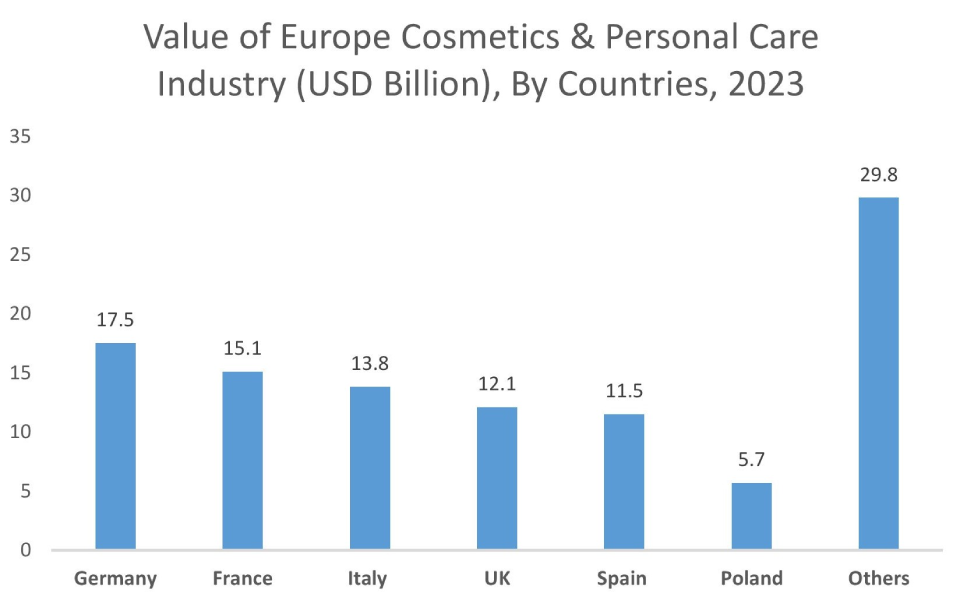
Acetamide MEA Market Segmental Analysis :
By Product Type:
Based on product type, the market is segmented into 75% purity and 100% purity.
Trends in the product type:
- Increasing trend in the adoption of acetamide monoethanolamine with 75% purity in cosmetics and personal care formulations, attributing to its optimum balance of efficacy and cost-effectiveness.
- Rising adoption of acetamide monoethanolamine with 100% purity in specialized and premium cosmetics & personal care products is driving the market.
The 75% purity segment accounted for the largest revenue in the total acetamide MEA market share in 2024.
- Acetamide monoethanolamine with 75% purity grade is widely used in cosmetics and personal care formulations due to its optimum balance of efficiency and cost-effectiveness.
- It is commonly used in cosmetics and personal care products such as conditioners, shampoos, and lotions, which emphasize product mildness and hydration.
- Moreover, acetamide monoethanolamine with 75% purity offers benefits such as compatibility with several formulations and ease of processing, which further makes it a versatile option for manufacturers.
- Additionally, the increasing shift towards adopting economical yet high-efficacy ingredients in mass-market personal care products is driving the adoption of acetamide monoethanolamine with 75% purity grade.
- According to the analysis, the aforementioned factors are driving the market demand.
The 100% purity segment is anticipated to register the fastest CAGR growth during the forecast period.
- Acetamide monoethanolamine with 100% purity grade is mostly used in specialized and premium cosmetics & personal care products that require high performance and minimal impurities.
- Moreover, rising advancements in the formulation of high-end cosmetic products with exceptional conditioning and hydrating properties are driving the 100% purity segment.
- Additionally, the rising focus on clean beauty formulations and organic certifications is further propelling the adoption of 100% purity acetamide monoethanolamine in niche markets, particularly in premium cosmetic & personal care product formulations.
- Hence, the aforementioned factors are anticipated to drive the market during the forecast period.
By Function:
Based on function, the market is segmented into conditioning agent, skin conditioning agent, surfactant, humectant, and thickener.
Trends in the function:
- Rising trend in the utilization of multifunctional ingredients in hair care formulations for enhancing product efficiency is driving the market.
- Increasing trend in the adoption of acetamide monoethanolamine as a humectant in cosmetics & personal care products, due to its ability to effectively attract and retain moisture in skin and hair care formulations.
Conditioning agent segment accounted for the largest revenue share in the overall acetamide MEA market share in 2024.
- Acetamide MEA is widely used as a conditioning agent in hair care products such as shampoos and conditioners for improving texture, manageability, and softness.
- Moreover, the increasing utilization of multifunctional ingredients in hair care formulations for enhancing product efficiency is driving the segment development.
- Additionally, the ability of acetamide monoethanolamine to reduce frizz and provide long-lasting hydration is further increasing its adoption in high-performing hair care products.
- Therefore, the increasing adoption of acetamide monoethanolamine as a conditioning agent in hair care products is driving the acetamide MEA market trends.
The humectant segment is anticipated to register the fastest CAGR growth during the forecast period.
- Acetamide monoethanolamine is often used as a humectant in cosmetics & personal care products, due to its ability to effectively attract and retain moisture in skin and hair care formulations.
- Moreover, the growing need for hydrating products in the skincare and haircare sectors is among the key factors driving the segment development.
- Additionally, the increasing adoption of bio-based and skin-friendly humectants in skin care formulations for targeting dry and sensitive skin is expected to provide lucrative prospects for segment growth.
- Hence, the aforementioned factors are anticipated to boost the acetamide MEA market growth during the forecast period.
By Application:
Based on the application, the market is segmented into cosmetics, personal care products, and others.
Trends in the application:
- The adoption of acetamide monoethanolamine in personal care products is driven by factors including its versatility and growing consumer preference for lightweight and hydrating formulations in personal care products.
- Factors including increasing research & development in advanced skincare formulations along with rising production of skincare and beauty products are driving the market.
The personal care products segment accounted for the largest revenue share of 46.32% in the total market in 2024.
- Acetamide monoethanolamine is primarily used in personal care products such as shampoos, body lotions, conditioners, and creams, attributed to its hydrating and conditioning properties.
- Moreover, the growing consumer preference for lightweight and non-greasy formulations in personal care products is driving the adoption of acetamide monoethanolamine.
- Additionally, the improved compatibility of acetamide monoethanolamine with other active ingredients ensures its widespread adoption across a diverse range of personal product categories.
- According to the analysis, the above factors are driving the acetamide MEA market size.
The cosmetics segment is anticipated to register the fastest CAGR growth during the forecast period.
- The cosmetics sector is increasingly utilizing acetamide monoethanolamine in formulations, including primers, foundations, setting sprays, and others, due to its hydrating and skin-conditioning properties.
- Moreover, the increasing adoption of multifunctional ingredients in cosmetic products for improving performance and enhancing consumer satisfaction is driving the market demand in this segment.
- Additionally, the ability of acetamide monoethanolamine to improve product texture and spreadability is further boosting its adoption in premium and mass-market cosmetic products.
- Hence, the rising adoption of acetamide monoethanolamine in cosmetic products is expected to drive the market during the forecast period.
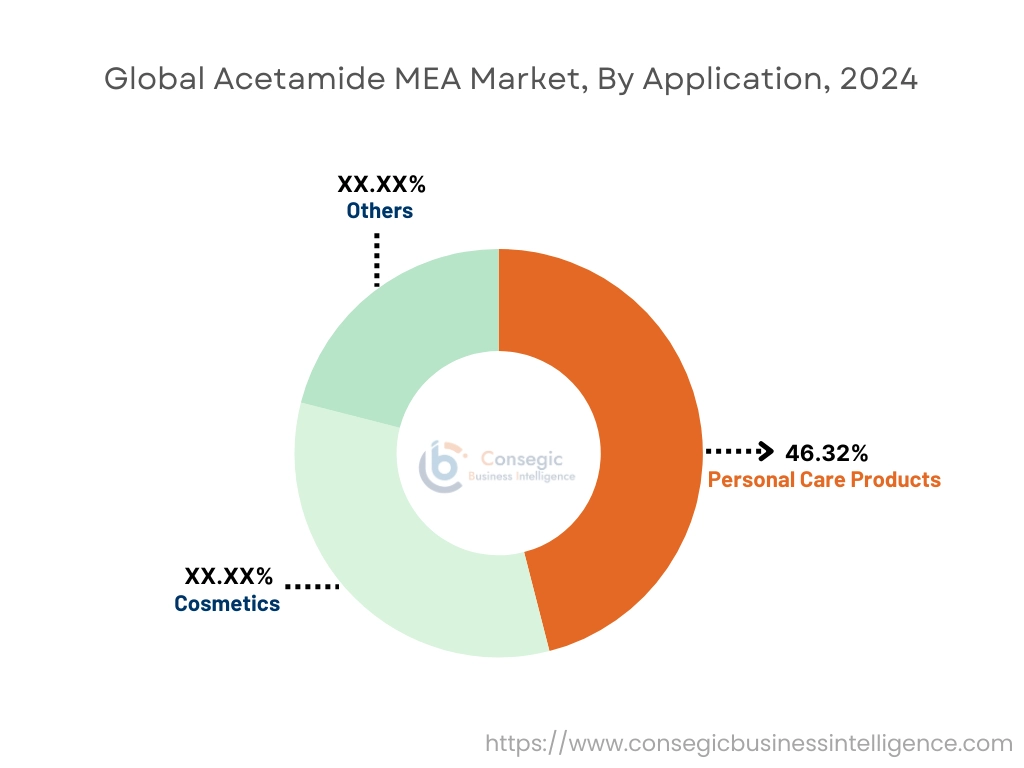
Regional Analysis:
The regions covered are North America, Europe, Asia Pacific, the Middle East and Africa, and Latin America.
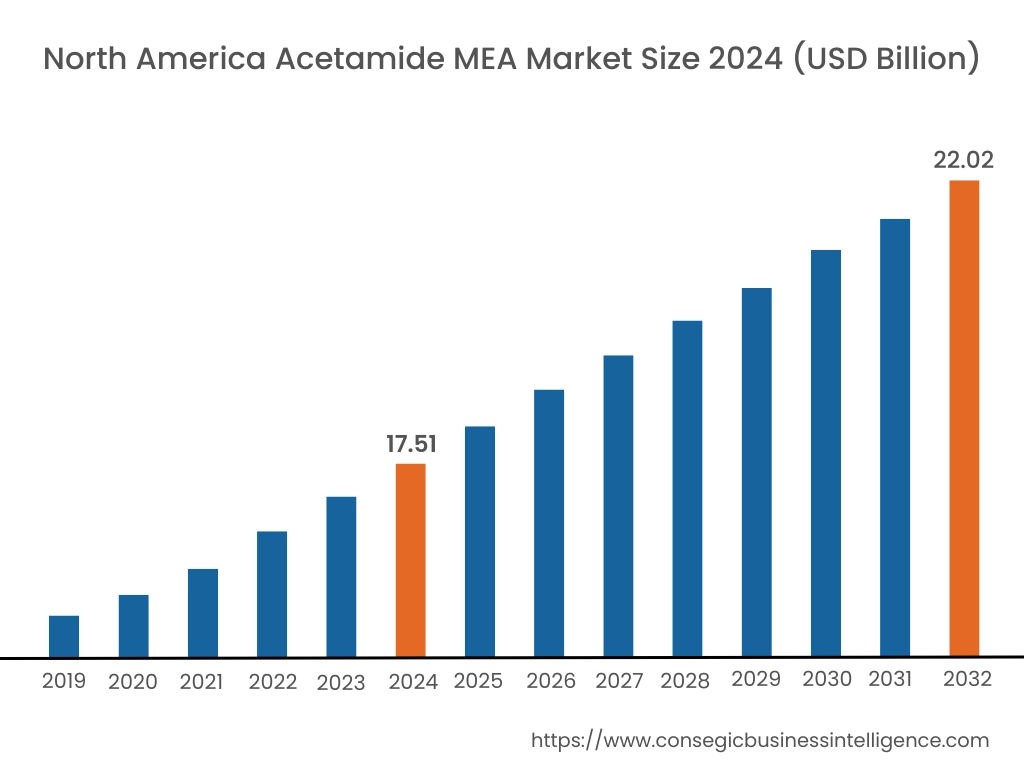
In 2024, North America was valued at USD 17.51 Billion and it is expected to reach USD 22.02 Billion in 2032. In North America, the U.S. accounted for the highest share of 71.20% during the year 2024. In North America, the growth of the acetamide MEA industry is driven by its increasing adoption in the cosmetics & personal care sector. Moreover, factors including the rising production of cosmetics & personal care products and the increasing need for conditioning and hydrating ingredients in personal care products are contributing to the acetamide MEA market demand.
- For instance, according to the International Trade Administration (ITA), the cosmetics sector in Canada generated a revenue of approximately USD 1.8 billion in 2024. The above factors are expected to boost the acetamide MEA market trends in North America during the forecast period.
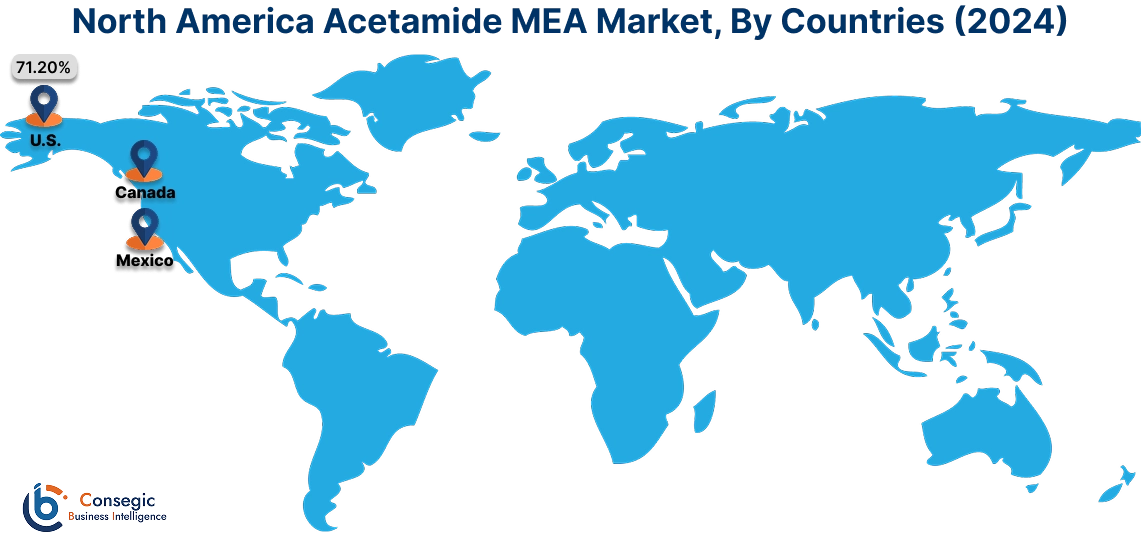
Asia-Pacific is expected to witness the fastest CAGR of 3.6% over the forecast period (2025-2032). As per the acetamide MEA market analysis, the adoption of acetamide monoethanolamine in the Asia-Pacific region is primarily driven by the expanding cosmetics & personal care sector, particularly in countries such as China, Japan, South Korea, and India. Moreover, factors such as large-scale production of personal care products, rising consumer preference for effective moisturizing and conditioning ingredients in skincare/haircare products, and rising developments associated with advanced skincare formulations are key aspects driving the market in the region.
- For instance, according to the Japan Cosmetic Industry Association (JCIA), skincare cosmetics accounted for 43.6% of the total cosmetics shipments in Japan in 2023, followed by hair care with 28.0%, makeup products with 20.7%, specific-use cosmetics with 7.0%, and perfume with 0.7%. Thus, the above factors are accelerating the acetamide MEA market expansion in the Asia-Pacific region.
In addition, the regional analysis depicts that the growing need for high-quality cosmetics & personal care products along with the increasing popularity of luxury beauty products including moisturizing creams, hair conditioners, and others are key factors driving the acetamide MEA market demand in Europe. Further, as per the acetamide MEA market analysis, the market demand in Latin America, Middle East, and African regions is expected to grow at a considerable rate due to factors such as growing cosmetics & personal care sector, along with increasing production of skincare and haircare products, among others.
Top Key Players & Market Share Insights:
The global acetamide MEA market is highly competitive with major players providing services to the national and international markets. Key players are adopting several strategies in research and development (R&D), product innovation, and end-user launches to hold a strong position in the acetamide MEA market. Key players in the acetamide MEA industry include-
- Solvay SA (Belgium)
- The Lubrizol Corporation (United States)
- Croda International Plc (United Kingdom)
- Jeen International Corporation (United States)
- Henan Tianfu Chemical Co., Ltd. (China)
- Vantage Specialty Chemicals (United States)
- Redox Pty Ltd. (Australia)
- Henan DaKen Chemical Co., Ltd. (China)
- Shanghai Time Chemicals Co., Ltd. (China)
- ALB Technology Limited (United States)
Recent Industry Developments :
Innovations:
- In 2024, Lubrizol introduced Schercomid™ AME-75 monoalkanolamide, a versatile humectant and conditioning agent used in various hair and skin formulations. This development addresses the growing demand for mild, effective ingredients in personal care products. Schercomid™ AME-75 acts as a coupling and wetting agent, pigment dispersant, and solubilizer, providing enhanced conditioning properties. It is recommended for use in concentrations ranging from 0.5 to 5.0 wt%, offering a sustainable solution for the formulation of hair conditioners, moisturizers, and other skin care products. This product aligns with the increasing consumer preference for mild and multi-functional ingredients in cosmetics.
Acetamide MEA Market Report Insights:
| Report Attributes | Report Details |
| Study Timeline | 2019-2032 |
| Market Size in 2032 | USD 67.93 Billion |
| CAGR (2025-2032) | 3.2% |
| By Product Type |
|
| By Function |
|
| By Application |
|
| By Region |
|
| Key Players |
|
| North America | U.S. Canada Mexico |
| Europe | U.K. Germany France Spain Italy Russia Benelux Rest of Europe |
| APAC | China South Korea Japan India Australia ASEAN Rest of Asia-Pacific |
| Middle East and Africa | GCC Turkey South Africa Rest of MEA |
| LATAM | Brazil Argentina Chile Rest of LATAM |
| Report Coverage |
|
Key Questions Answered in the Report
What is the expected size of the Acetamide MEA market by 2032? +
The market is projected to reach USD 67.93 billion by 2032, growing at a CAGR of 3.2% from 2025 to 2032.
What factors are driving the growth of the Acetamide MEA market? +
Increasing applications in personal care and pharmaceutical products, rising demand for moisturizing and conditioning agents, and advancements in cosmetic formulation technologies are key growth drivers.
Which segment holds the largest market share? +
The 75% purity segment dominates due to its cost-effectiveness and widespread use in shampoos, conditioners, and skincare formulations.
Which region is expected to grow the fastest? +
The Asia Pacific region is anticipated to witness the highest CAGR of 3.6% due to expanding cosmetics and personal care sectors in China, India, and Japan.
